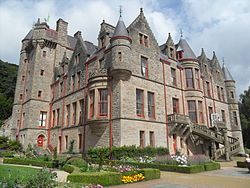Belfast Castle
| Belfast Castle | |
| County Antrim | |
|---|---|
 Belfast Castle | |
| Location | |
| Grid reference: | J32887911 |
| Location: | 54°38’34"N, 5°56’32"W |
| City: | Belfast |
| History | |
| Built 1811 to 1870 | |
| For: | 3rd Marquess of Donegall by Charles Lanyon |
| Country house | |
| Scots baronial | |
| Information | |
| Owned by: | Belfast City Council |
Belfast Castle is a grand country house of the Chichester family standing on the slopes of Cavehill Country Park in Belfast, and in County Antrim. Its prominent position 400 feet above sea level provides unobstructed views of the city of Belfast and Belfast Lough.
The Castle has since the early twentieth century been reduced to being a municipal amenity, with a shop, restaurant and conference facilities, its gardens becoming a public park.
History
The original Belfast Castle, built in the late 12th century by the Normans,[1] was located in the town itself, flanked by the modern day High Street, Castle Place and Donegall Place in what is now Belfast city centre. This castle was eventually inherited by Arthur Chichester, 1st Baron Chichester (better known as Sir Arthur Chichester) and served as his home, but it burned down in 1708, leaving only street names to mark the site.
Rather than rebuild on the original site, the Chichesters decided to build a new residence in the city's suburbs, and the result was today's Belfast Castle.
The building that stands today was built between 1811 and 1870 by George Chichester, 3rd Marquess of Donegall. It was designed in the Scots baronial style by Charles Lanyon and his son, of the architectural firm Lanyon, Lynn and Lanyon. After Lord Donegall's death and the family's financial demise, the 8th Earl of Shaftesbury completed the house.
In 1934, Shaftesbury's son, the 9th Earl of Shaftesbury, presented the castle to the City of Belfast. In 1978, Belfast City Council began a major refurbishment over a period of ten years at a cost of over two million pounds and the building officially re-opened to the public on 11 November 1988.
The castle boasts an antiques shop, a restaurant and visitors centre and it is a popular venue for conferences, private dining and wedding receptions.
Outside links
| ("Wikimedia Commons" has material about Belfast Castle) |
- Belfast Castle
- All About Belfast Castle at The Northern Ireland Guide
- Panoramic virtual tour of the castle, gardens & view
- Castle Catering NI